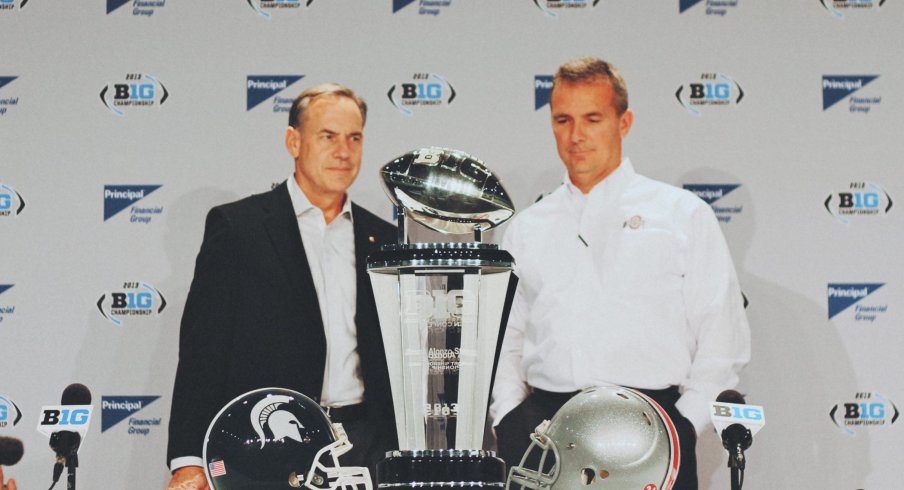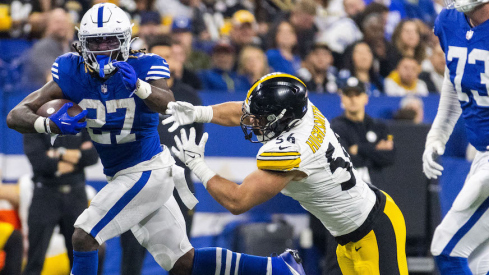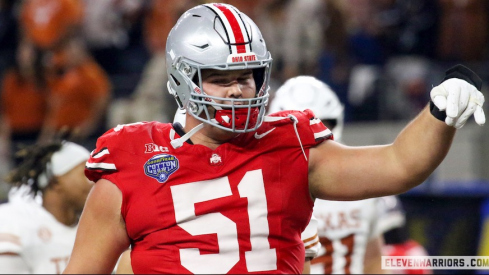Four-star 2026 cornerback Jordan Thomas commits to Ohio State.
Ohio State fans are currently experiencing a 'golden age' in the program's history. So are their new rivals in East Lansing.
While Urban Meyer has the Buckeyes consistently near the apex of the college football universe, going 50-4 over the past four seasons, head coach Mark Dantonio has returned Michigan State to that same stratosphere for the first time since the 1960s. Though often looked over in favor of their in-state rivals, the Spartans followed up a Rose Bowl berth in the 2013 campaign with a trip to this past season's College Football Playoff, cementing their place as a realistic national title contender.
Both postseason trips were granted the same way though: by first beating Ohio State. In Meyer's four years at the helm, two of those four losses have come at the hands of Dantonio's Spartans, with the Buckeyes failing to reach their own championship goals both seasons.
The programs have truly become each other's nearest and greatest hurdle, even if still not their biggest traditional rival. For years, the two schools shared a great deal in common, sharing a distaste for anything that went on in Ann Arbor and regularly rooting for one another to win there.
Dantonio himself has a strong connection to the Buckeye state, having coached at Ohio University, Akron, Youngstown State, Cincinnati, and of course as Jim Tressel's defensive coordinator for the 2002 National Championship team at Ohio State. This influence over one of the midwest's top producers of talent has been a major factor in his renovation of the program in East Lansing, with stars like Connor Cook, Greg Jones, Le'Veon Bell, and Jerel Worthy all having headed northwest to play their college ball.
Both teams have had strong production on either side of the ball during this stretch, but one particular matchup has come to define the outcome in each of the past three seasons: the Ohio State offense against the Michigan State defense. Perhaps it was meant to be this way, with Meyer's reputation as a 'spread offense' visionary and Dantonio's history working for Nick Saban in the 1990s, the same man that effectively ended Meyer's reign over the SEC once his defenses took hold at Alabama.
But both sides lost what many thought to be the engines of their success one year ago, as OSU offensive coordinator Tom Herman and MSU defensive coordinator Pat Narduzzi each left to take over as the head coaches at the Universities of Houston and Pittsburgh respectively. Yet even with their departure, the 2015 contest was defined by Dantonio's defense and their ability to earn an upset victory in Columbus, holding the Buckeyes to only 14 points.
The Spartan defense has long been one of the nation's best units thanks to their 'Quarters' coverage, which allows the secondary to simultaneously defend deep passes and stop the run at once. Against the Buckeyes, this has often meant that the Safety to the side of the tight end has dropped down to give MSU an extra defender in the box, stuffing the inside running game upon which the OSU offense so relies.
Given the slim margin for error on either side, this specific tactic used by Dantonio's defense has become the fulcrum for the game plans on both sides. The Spartans will try whatever they can to keep that extra defender near the line, shutting down the engine of the Buckeye offense. Meanwhile that same offense will try to attack the thin back end, which often asks only three or four players to defend the perimeter and downfield passing games. As soon as one side finds the weakness in the other's plan, the rest of the game plan seemingly crumbles with it.
The Spartans laid this foundation in the 2013 Big Ten Championship game, making it clear that even though Ohio State quarterback Braxton Miller was the reigning conference player-of-the-year, he was going to have to beat them with his arm. The MSU defense swarmed the line consistently, leaving Miller and running back Carlos Hyde with nowhere to go all night.

As the Buckeyes made their way north the following October, they knew that exploiting the aggressive play of the Spartan safeties was required in order to get a much-needed win on the road.
One of the Buckeyes' favorite plays in this stretch has been the 'Split-zone' quarterback run, in which the tight end lines up in the backfield, but comes across the formation to deliver a 'Wham' block on the opposite end. The quarterback then looks for a seam to run inside, often just inside of that crucial block from the tight end.
While effective, the tight end's movement across the formation like that was a clear read of a run for the Spartan defense, meaning the strong safety often flew up toward the line immediately after seeing it. However, with that strong safety running forward, the free safety often opened up toward the middle of the field, dropping to defend what was effectively two quarters of the field instead of one.
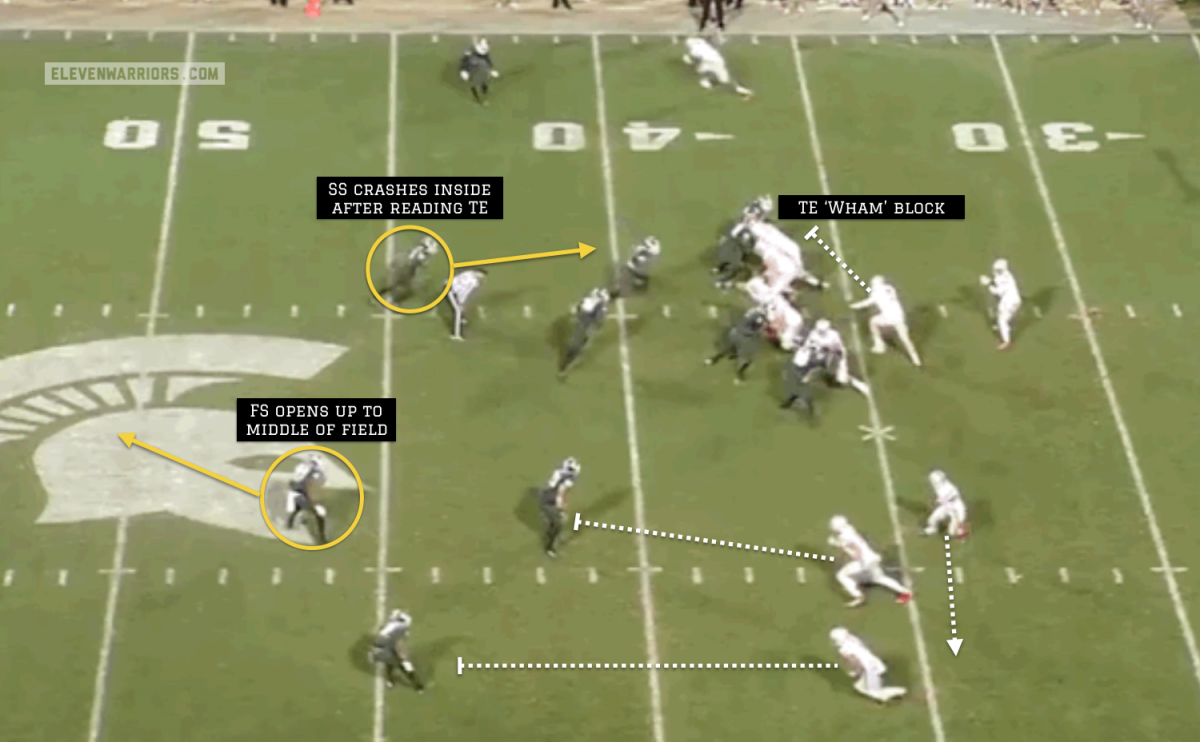
Knowing the tight end's movement would trigger this reaction from the Spartan safeties, the Buckeyes took advantage of the space they left unguarded. Quarterback J.T. Barrett had an easy throw on a bubble screen to the wide side of the field, giving receiver Jalin Marshall two lead blockers for the only two defenders to that side on a simple bubble screen.

The same free safety that had retreated to the middle of the field now has to come all the way back to the numbers to make a tackle, but not before Marshall can pick up the first down. This concept of identifying the stretched defender(s) on the back end was clearly by design, and would become a pattern by night's end.
One of the game's biggest plays was a result of this philosophy, as Michael Thomas took a simple slant pattern 79 yards for a touchdown after breaking a single tackle, going untouched the rest of the way.

While the missed tackle was obviously not what Dantonio was looking for, the other 10 defenders on the field were nowhere to be found for a reason; they were simply doing as instructed. By initially showing that same 'Wham' action from the tight end (this time with a back taking the handoff), the strong safety once again flies upfield, leaving his teammates in the secondary all alone.
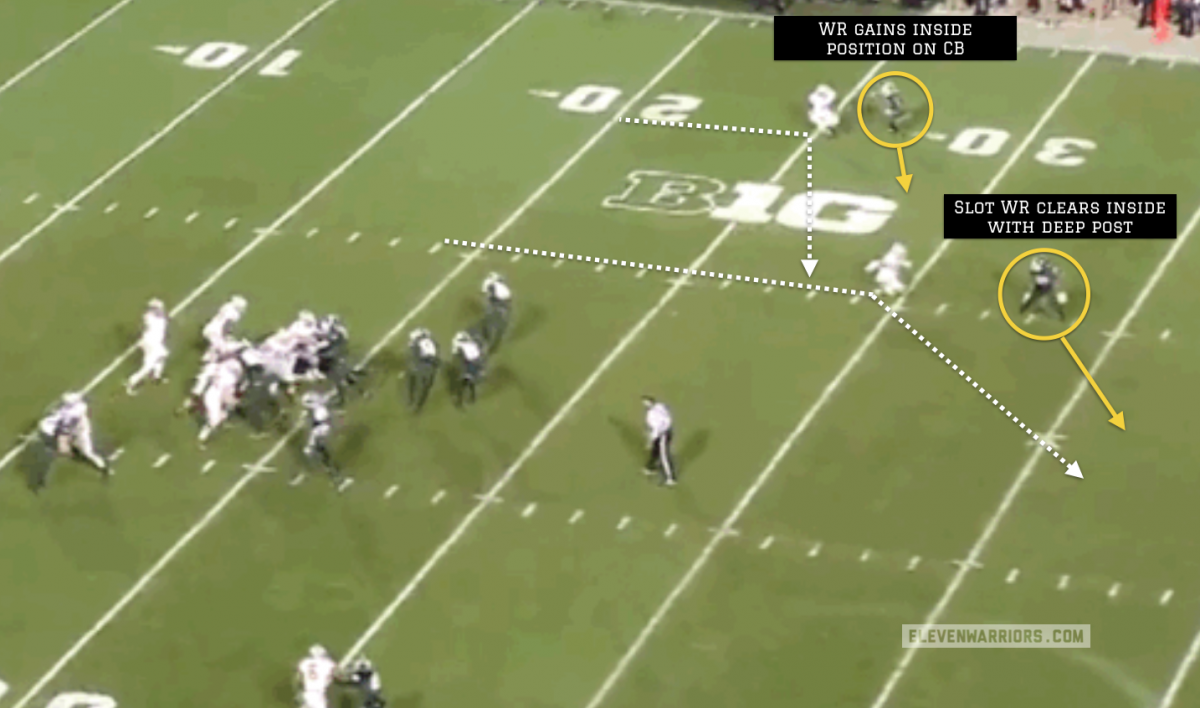
The OSU receivers to the wide side are running a simple Post/Slant combination, with the slot to the inside clearing out the area where Thomas' slant will immediately fill the void. Thomas uses his big body to gain an inside position on the isolated cornerback, much the same way a rebounder boxes out on the basketball court, and Barrett throws an easy pass while eight Spartan defenders scramble to get back in coverage. With one safety nearly at the line of scrimmage and the other making sure the slot receiver doesn't run straight to the end zone, the corner is all alone and forced to lunge for an ill-fated tackle attempt through which Thomas easily runs.
By attacking these isolated defenders on the wide side of the field, the Buckeyes could gain a serious advantage by simply stretching the area in which they'd have to cover. Even without the threat of a run, Ohio State could isolate individual defenders with simple route combinations, knowing the Spartans would rarely call a coverage other than their base 'Quarters' look on early downs.
One such combination that gives that coverage issues is the 'Smash' concept, in which an outside receiver runs a simple hitch or curl pattern, turning to the inside, while the inside receiver runs a corner pattern behind it. When in 'Quarters,' the cornerbacks are responsible for the outside man if he runs vertically, and the hitch route is just that. Meanwhile, the corner route from the inside should also be considered the corner's responsibility, as it breaks to the outside quarter of the field.
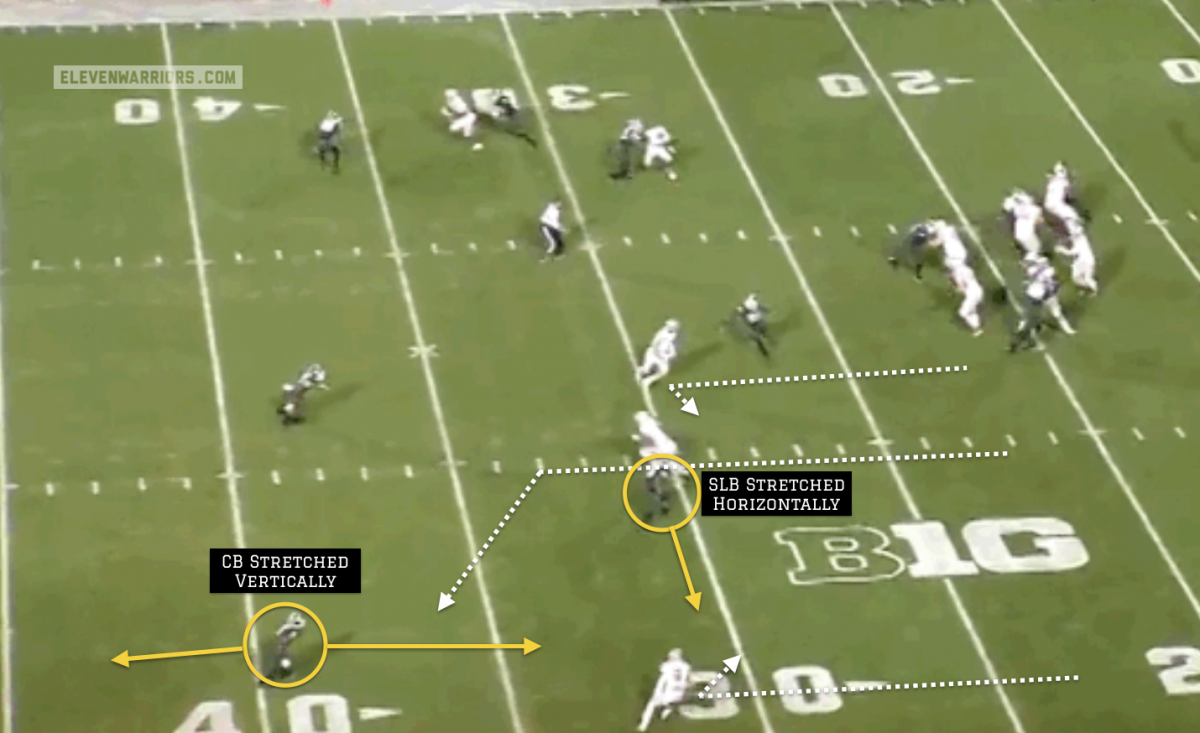
The corner is now stretched vertically, as he must choose between which pattern to cover. To be safe, he drops deeper to take away the corner route, leaving the outside linebacker to get over and help cover the outside hitch.
But since the Buckeyes were attacking the wide side of the field, that outside linebacker has to get from the hash marks to the numbers, a full 10 yards away from the receiver. This horizontal stretch on the linebacker is set thanks to a third route to the inside from the tight end, who is also running a short hitch or 'stick' pattern and making the outside linebacker split the distance between both players, leaving at least one of them open.

The Buckeyes would use a number of slight variations off the Smash pattern throughout the game, stretching the corner and safety to the wide side and turning underneath throws into first downs. With the other seven or eight defenders playing the run so aggressively, the remaining players on the back end had no choice but to give up these short passes in order to keep the threat of the deep ball at bay.

With a clear focus on taking the intermediate throws the defense couldn't cover, the Buckeyes were finally able to crack open the rest of their offense that night. Devin Smith would eventually take the top off with a deep, 44-yard touchdown catch that seemed to be the breaking point for Michigan State.
Knowing their back end couldn't contain the OSU passing game, the Spartans had to play more conservatively against the run, which allowed the Buckeyes to finally establish their inside ground game. Running back Ezekiel Elliott finished the night with 154 yards and two touchdowns on an impressive 6.7 yards-per-carry.
That victory seemed to springboard the Buckeyes into another level of respect nationally, erasing any negative talk about Meyer's ability to get past his newest foil. But while the following few months would be magical for the 2014 Ohio State squad, the hurdle was not permanently cleared.
The 2015 matchup between these saw the Spartans make a counter-move of their own, once again claiming the upper hand in what has become one of the nation's premier chess matches between coaching minds. We'll explore how they did so next week in part II of this series.
